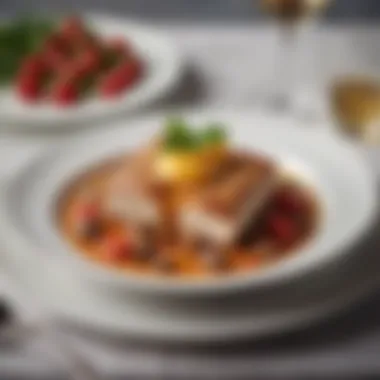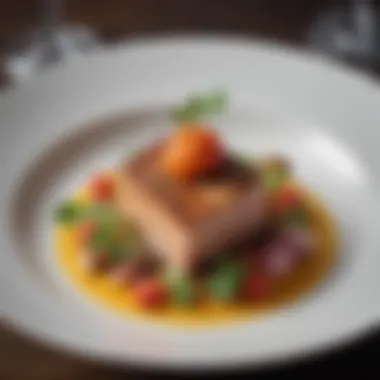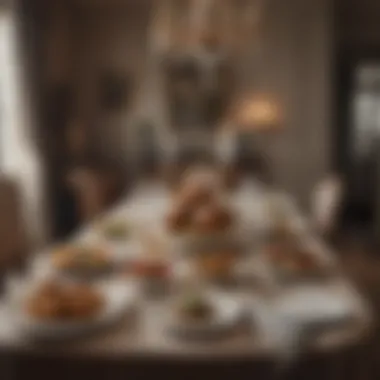Exploring the French Menu: A Guide to Culinary Delights


Intro
French cuisine is celebrated worldwide for its variety, depth, and elegance. It holds both nostalgia for traditional methods and adapts to modern trends. This dual identity paves the way for exploration into a diverse and flavorful menu.
Traditional French dishes often reflect the culture and regional ingredients sourced in specific areas. Each plate tells a story, connecting diners to the rich history of France. At the same time, contemporary French cuisine shows an ongoing evolution, embracing influences from around the globe while maintaining core techniques and values.
Understanding the layout of a traditional French menu is essential. Typical structure includes appetizers, main courses, cheeses, and desserts, with each section representing not only food options but cultural dimensions as well. This article aims to provide insight into both facets of French cuisine. By acknowledging classic recipes and contemporary twists, readers gain a comprehensive foundation for appreciating and recreating these culinary art forms.
With both context and recipes explored, anyone from the novice cook to seasoned home chefs can find inspiration to elevate their own kitchen practices.
Recipe Highlight
Coq au Vin
This classic dish combines tender chicken with red wine, mushrooms, onions, and sometimes smoked bacon. It exemplifies traditional techniques while being surprisingly accessible for most home cooks.
Essential Ingredients
- 1 whole chicken, cut into pieces
- 3 cups red wine
- 2 cups mushrooms, sliced
- 1 cup pearl onions
- 4 ounces of bacon, diced
- 2 tablespoons flour
- Fresh thyme and bay leaves
Preparation Time
Approximately 1 hour and 30 minutes.
Servings Serves 4-6 people.
Step-by-Step Instructions
- In a large pot, cook the bacon over medium heat until it becomes crisp.
- Remove the bacon and set it aside. In the bacon fat, lightly brown the chicken pieces on all sides.
- Add the pearl onions and sliced mushrooms, cooking until tender.
- Sprinkle flour over the mixture and stir well to coat.
- Pour in the wine and add the reserved bacon, thyme, and bay leaves. Stir.
- Allow it to simmer for about an hour, until the chicken is tender.
- Adjust seasoning with salt and pepper as needed.
Note: Patience is key in developing flavors; slow cooking enhances the dish.
Variations and Substitutions
- You can use white wine for a lighter version, leading to different yet delicious results.
- Consider adding root vegetables such as carrots or potatoes for extra texture.
- For a heartier experience, serve with crusty bread rather than rice or mashed potatoes.
Time-Saving Cooking Tips
- Prepare chopped ingredients and marinate the chicken the day before cooking.
- Using a food processor can cut cooking time for dicing vegetables.
- Making a larger batch can help prepare meals for the week ahead. Reheat and enjoy.
Nutritional Information
- Calories: Approximately 350 calories per serving.
- Rich in protein from chicken; covers significant vitamin and mineral needs from vegetables.
- Suitable for various diets by using gluten-free flour and substituting ingredients.
Through this examination of Coq au Vin, one can appreciate both the traditional roots and future potential of French cuisine while feeling confident to attempt this dish in the comfort of home.
Preamble to the French Menu
Understanding the French menu is essential for anyone interested in culinary arts. French cuisine is known for its refinement and complexity, yet it remains accessible to home cooks. This section serves as an entry point into the broader tapestry of traditional and contemporary dishes. The varied components, from appetizers to desserts, reflect both history and modern tastes.
The French menu showcases not only food but also the culture and social norms surrounding dining.
Appreciating traditional dishes enhances the experience of eating and cooking French meals. Authentic recipes often come nested within unique tales of their origins. Familiarity with classic ingredients and preparation methods can inspire creativity in modern adaptations. By exploring this area, readers gain insight into culinary standards while valuing personal touch in their creations.
Additionally, knowledge of the overall structure aids professional and amateur chefs. Certain culinary techniques linked to historic French practices underpin the preparation of numerous international foods. The combination of serving ideas enrich ideas for meal presentations at home.
In short, this exploration of the French menu lays a strong foundation for grasping culinary traditions while making space for experimentation. Knowing why plates remain important connects people culturally, creating both enjoyment and understanding in every meal.
"A generous menu offers flavours, style, and emotions alike—they undoubtedly share an experience across cultural divides."
Historical Context of French Cuisine
Understanding the historical context of French cuisine is essential for appreciating its richness and diversity. French cooking did not evolve in isolation. Many influences formed its backbone, making it a complex tapestry of flavors, techniques, and traditions. Land and climate conditions across France not only shaped its agricultural practices but also designated what was local food. Such conditions had a pivotal impact on what ingredients became integral to particular regional cuisines.
Furthermore, French cuisine reflects historical events, social structures, and even economic predicaments. For instance, the notion of gastronomy as it exists today has deep roots in the French monarchy and its courtly practices. By examining historical trends, we can discern shifts in the nation’s food consciousness. From royal banquets to peasant hearths, each era contributed uniquely to today's dining palate.


Evolution of French Cooking Techniques
The evolution of French cooking techniques showcases the engineering of modern gastronomy. Early methods were often influenced by necessity and availability. Traditional techniques rooted from monastic kitchens who sought simple preparation of local fare. Methods such as confit, where meat is slowly cooked in its fat, were practical for preservation. As time moved on, culinary arts flourished within the bastions of gastronomy.
During the Renaissance, the French brought refined cooking techniques from Italy. This initial introduction paved the way for haute cuisine. A proper focus on presentation became unmistakably paramount. Master chef Georges Auguste Escoffier further revolutionized these notions, classifying and codifying contemporary culinary techniques still used today, such as julienne (for thin strips of vegetables) or sous-vide (the vacuum-sealing process).
Tiny, delicate movements, once simple food techniques, now remind one of finer grandiosity of meals enjoyed.
Regional Influences on the French Menu
The regional influences on the French menu are a heartening illustration of the country’s geographical rihgness. Each region boasts its traditional ingredients and methods tailored to local tastes and environment. For example, Provençal dishes are laden with olive oil, fresh vegetables, and herbs, a direct connection to the warm Mediterranean climate. In contrast, Alsace grimps its culinary offerings from the nearby Germany, comprising hearty sausages and flammekueche.
Meanwhile, Normandy offers an array of dairy products, famous for producing Camembert cheese and delectable butter. Each regional culture nurtures their culinary habits, transforming what might seem ordinary into something extraordinary.
- Local Dishes: evidence of necessity creating famed gastronomy, showing vast variations.
- Cultural Significance: instills pride in local identities.
Components of a Traditional French Menu
A traditional French menu is a carefully curated experience that reflects the depth and variety of French cuisine. Understanding its components is crucial for both appreciation and execution, especially for those looking to replicate this culinary artistry at home. Each element plays a significant role, from setting the tone of the meal to exemplifying the cultural richness of France.
Appetizers: The Starters
Examples of Classic French Appetizers
Classic French appetizers, or "les hors d'oeuvre," serve as an introduction to the dining experience. Examples like Gougères (cheese puffs) or Escargots de Bourgogne (snails in garlic butter) display not only flavor but also sensory elegance. These dishes highlight France's emphasis on cooking with high-quality ingredients, transforming simple foods into extraordinary starters. Each appetizer has a unique place within the overall meal, setting the mood and preparing the palate for what is to come. Many of them offer robust flavors that entice guests, making them a popular choice.
In making a classic French appetizer, complex flavors toggle between richness and freshness, inviting intrigue. However, they often require time for preparation and skill, presenting a potential challenge for novice cooks.
Importance of Presentation
The art of presentation holds significant importance in French dining. A well-presented dish can elevate the dining experience, highlighting the chef’s skill and creativity. L'importance de la présentation reflects not just aesthetic qualities but also thoughtfulness in menu design. For any meal, this dedication illustrates the care shown by the cook.
Indeed, incorporating a distinct visual flair creates an inviting atmosphere. However, focusing too much on presentation might detract from the enjoyment of the dish itself. Striking a balance is key, enhancing without overshadowing taste.
Main Courses: The Entrées
Meat-based Dishes
In traditional French cuisine, meat-based dishes hold a central position. Dishes like Boeuf Bourguignon or Duck Confit exemplify rich flavors developed through slow cooking methods. These meals reveal the capability of transforming meats into remarkable experiences. The various techniques, such as braising or roasting, unlock flavors that resonate deeply with the essence of French cooking.
The unique characteristic of meat-based French dishes lies in their ability to entice the senses. They serve as the heart of the meal, creating atmosphere and depth. For those wishing for depth on their menus, these hearty entrees are often worth the effort due to their cultural significance and responses from diners, albeit they frequently demand patience in preparation.
Vegetarian Options
As modern dining evolves, vegetarian options have grown within the French culinary framework. Dishes like Ratatouille and Pissaladière provide a wonderful commentary on how traditional cuisine adapts to changing tastes. Balancing flavors encourages diverse contributions to French dining. Such offerings appeal to a wider audience without being dismissive to the cuisine's beautiful essence.
The characteristic benefit of vegetarian dishes is the ability to showcase seasonal vegetables, sparking new perspectives on familiar tastes. They ease the preparation burden, as they can often be made quickly, which may offer balance for cooks looking for less-intensive meals.
Cheeses and Bread
Varieties of French Cheese
French cheese is renowned: from Brie de Meaux to Roquefort, varieties contribute richness to the traditional menu. Legends arise from the attention to local ingredients, crafting unique flavors tied to regions and rituals. France has approximately 1,200 types of cheese, evidencing its vast diversity and cultural importance.
The unique feature of French cheese lies in its ability to create shared experiences. It encourages conversation, tone and togetherness around the dining experience. However, carefully selecting cheeses may take both time and a keen eye for good pairings to ensure the best harmony within any meal invitation.
Role of Bread in French Dining
Bread, particularly the famous baguette, holds essential ground in French dining culture. Serving as both a staple and symbol, it is integral to balancing meals. Each dining experience places a focus on highlighting its texture and flavor alongside the dishes served. With options like Pain de Campagne or Fougasse, bread provides versatility on any menu.
It features characterize how diners experience the meal as it invites immediate integration with other elements on the table. Still, too much focus on quantity over quality can often lead to subpar bread offerings, diluting meal delight.
Desserts: The Sweet Concludes
Classic French Desserts


Classic desserts such as Crème Brûlée or Éclairs serve important roles. They often showcase intricate techniques and layered flavors. Their compelling characteristics lie in sweet refreshment at the end of meals, leaving diners with memories long after festivities conclude.
The feature of creating these classic desserts demands skills of precision and time but holds a famed reputation. By ending meals with desserts, it summarizes the culinary journey taken during the meal.
Modern Interpretations
Modern French desserts draw inspiration while implementing new ideas and techniques. Options like Mille-Feuille with unexpected fillings or innovative soufflés illustrate this shift. Chefs balance maintaining authenticity while infusing creativity.
This adaptation shows the popularity of flexibility within culinary masterpieces. Yet, careful attention is necessary to preserve roots while appealing to contemporary palates which changes culinary fabric.
Ultimately, understanding the components of a traditional French menu allows enthusiasts and cooks to appreciate its rich layers and foster the diverse cultural tapestries behind each dish. By exploring its intricacies, you can reimagine and savor these experiences at home.
Understanding the Structure of a French Menu
In the realm of French culinary art, the menu serves as a roadmap through a stable of delightful choices. Understanding the structure of a French menu enriches one’s dining experience and sheds light on the thought placing behind meal curation. Each course is carefully designed not only to highlight individual dishes' flavors but also to reflect seasonal ingredients, regional specialties, and traditional practices. This artful assembly showcases the effort placed in creating balanced tastes and harmonious plates.
Typical Format and Terminology
A traditional French menu often consists of a precise sequence of courses, each fulfilling a unique function. The primary categories typically include hors d'oeuvre (appetizers), plat principal (main courses), fromage (cheeses), and dessert (dessert). A well-structured menu may also include various labeled sections, aiding diners in navigating the options presented.
Anatomical Breakdown
- Entrée: In many parts of the world, the term may refer simply to starters, but in French context, it often designates the main course itself.
- Deuxième Service: This section commonly includes meat and fish dished; others such as grains or vegetables may be served.
- Café: A common addition, reflecting the culture's deep appreciation for coffee as a concluding palate cleanser.
This structuring allows diners to prepare for the progression of flavors and ensures that expectation levels align with the restaurant’s style.
Wine Pairings and Their Cultural Significance
In French dining, wine pairings elevate each moment of the meal. Selecting an appropriate wine collapses the artistic expression seen in both food and drink, maximizing sensory satisfaction. Various regions in France showcase their locally-produced wines, heightening regional identity.
“Wine should ==always== be paired to enhance—never to overwhelm—a dish.”
The custom withwhich guests try to match wine with particular courses has become a focal part of both casual and formal dining. Key considerations include aspects such as:
- Aromatic profiles of the dishes
- Body of the wine
- Acidity levels present
- Temperature preferences
Learning about these combinations transforms a simple meal into an extraordinary experience. Remembering those intricate nothings not only honors cooking techniques but adds depth to each flavor lingering on your palate.
Modern Trends in French Cuisine
Modern trends in French cuisine indicate the evolving nature of this centuries-old tradition. They highlight how culinary practices adapt to meet contemporary demands and preferences. In today’s world, diners often seek more than just taste; they desire meals that reflect health, sustainability, and cultural diversity. Learning about these modern influences provides valuable insight into how French cuisine is navigating the complexities of the 21st century and engaging a broader audience.
Fusion Cuisine: Blending Cultures
Fusion cuisine represents one of the most exciting modern trends in French cooking. It embodies the collaboration between distinct culinary traditions, leading to innovative flavor profiles and presentations. Chefs often blend Asian, Middle Eastern, or even Latin American ingredients into traditional French dishes.
For instance, consider a classic French croissant filled with Vietnamese pork pâté or a Ratatouille that includes tropical fruits. These combinations are not merely experiments; they reflect the dynamic and multicultural landscape of modern gastronomy.
Benefits of Fusion Cuisine
- Diversity of Flavors: Introducing new ingredients enhances traditional recipes.
- Cultural Appreciation: This approach promotes cross-cultural understanding through shared dishes.
- Creative Expression: Chefs can reinterpret classic dishes, allowing for personal creativity and innovation in their cooking.
"Fusion cuisine highlights that the art of cooking is no longer limited by geographical or cultural boundaries."
Health Conscious Adaptations
Another essential trend is the increasing focus on health-conscious adaptations. With rising awareness about dietary choices, many restaurants now offer lighter options while retaining the essence of French cooking.
Substituting butter with olive oil or using whole grains instead of refined flour are examples of this trend. Moreover, chefs are crafting lighter sauces and providing vegan or gluten-free options. For example, a Crêpe made from buckwheat flour offers a nutritious alternative without sacrificing traditional flavors.
Considerations for Health-Conscious Adaptations
- Ingredient Quality: Using fresh and organic produce enhances not only flavor but also health.
- Balanced Nutrition: Combining protein, healthy fats, and vegetables caters to modern dietary preferences.
- Avoiding Artificial Ingredients: A focus on natural ingredients contributes to overall well-being.


Plant-Based French Recipes
The rise of veganism and vegetarianism has notably influenced modern French dishes. Plant-based French recipes allow the culinary traditions to expand while still embracing French culinary techniques.
Traditional dishes can now be crafted using plant-based alternatives. Dishes such as vegan Tarte Tatin rely on seasonal fruits with plant-based butter. Other ventures include Quinoa Salade Niçoise or a lentil-based version of Coq au Vin, preserving iconic essence while using alternative bases.
Benefits of Plant-Based Cooking
- Environmental Sustainability: Reduced meat consumption lowers food carbon footprints.
- Health Benefits: Plant-based diets offer better heart health and lower cholesterol levels.
- Culinary Innovation: Chefs can explore new territory by creating dishes that inspire tantalize without animal products.
Modern trends in French cuisine, including fusion, health adaptations, and plant-based recipes, allow this rich tradition to evolve. They reflect the changing priorities of society while attracting a diverse crowd of food lovers. As individuals embrace this evolving narrative, they can genuinely appreciate the depth and artistry embedded in French culinary practices today.
Popular French Dishes to Cook at Home
Knowing how to prepare popular French dishes opens a door to rich culinary experiences. Making these dishes at home allows cooks to connect with tradition and pass it down through generations. French food emphasizes quality ingredients and offers an array of flavors and techniques. For food lovers and home cooks, these recipes provide an opportunity to engage with this culture.
Step-by-Step Guides for Essential Recipes
Making Coq au Vin
Coq au Vin stands as a symbol of rustic French cooking. This dish relates deeply to the net of comfort, tradition, and bold flavors in French cuisine. Utilizing chicken, cooked in red wine, mushrooms, onions, and bacon, Coq au Vin reflects the importance of slow, careful preparation. This recipe showcases several French techniques, such as braising and managing flavors subtly.
The most striking characteristic of Coq au Vin is its adaptability. You can choose different types of wine—Burgundy is popular, though using Pinot Noir provides excellent results too. Each type alters the flavor, giving cooks the creative freedom, while offering structure in traditional techniques. Practically, making Coq au Vin enables connecting experiences spanning cultural narratives of deep enjoyment.
One advatage to this recipe is that its flavors improve post-cooking, meaning you can prepare it a day ahead and enhance your gathering or meal.
An aspect to consider is balancing the wine's acidity with the other ingredients. Ignoring this might result in flat tastes or overwhelming paltattes. Understanding balance elevates the experience.
Preparing Ratatouille
Ratatouille represents simplicity and the embrace of healthy ingredients. Commonly served as a side, it unites vegetables in a colorful dish that celebrates French rusticity while allowing for variations based on seasonality. Key here is understanding the flavor profiles of eggplants, zucchinis, bell peppers, and tomatoes, essential pillars in French rustic cuisine.
The beauty of Ratatouille lies in its vibrant touch with local produce. Cooks can utilize whatever is fresh, making it either a main or a supporting dish on the table. Due to its vegetable base, this makes it practical, fitting various dietary needs. It can echo health-driven trends in French cuisine maintaining warmth, passion, and care infused among implementation.
Consider the preparation techniques for Ratatouille. Sautéing versus roasting influences the flavors quite significantly. Sautéed versions might yield a lighter dish, while roasting draws out sweetness, acknowledging textures splendidly.
Tips for Authentic French Cooking
Engaging in authentic French cooking involves more than just ingredients and steps.
- Choose Quality Ingredients: Prioritize fresh, seasonal products as the foundation.
- Technique Over Speed: Allocate adequate time for cooking; layer flavors slowly rather than haste.
- Flavor Building: Look for the balance in flavors using aromatics and understand how to build taste gradually.
Final Thoughts on Embracing French Cuisine
French cuisine carries significant weight, weaving its threads through history, geography, and culture. In this exploration, it becomes clear that what makes French cooking undeniably compelling is its ability to integrate tradition with modern sensibilities. Both home chefs and restaurants now face a culture that is as much about creativity as it is about cultural respect. Embracing French cuisine offers insight into this rich legacy and inspires culinary satisfaction.
The Cultural Impact of French Cooking
French cuisine holds an esteemed position in global culinary discussions. Its principles have inspired chefs across continents. The careful preparation of dishes exemplifies an exactitude that garners global admiration. In many places, when we think of fine dining, the image of a tranquil French bistro often comes to mind.
Additionally, traditional dishes like Coq au Vin or Boeuf Bourguignon tell opulent stories of French regional heritage. Collectively, this culinary prowess hints at the complexities of elements: gastronomy, art, and history intricately fused over time. However, more important is the understanding that French cuisine is not exclusively elegant or intricate.
Everyday meals, like a simple ratatouille, can illustrate the heart of French home cooking. This aspect of cuisine helps highlight how crucial family and food are in French culture, creating bonds that often transcend mere sustenance.
“To share a meal is to share a story. Every recipe seems to whisper tales of their origins.”
In this way, the cultural impact of French cooking extends beyond just eating; it emphasizes a communal experience underpinned by tradition and transformation.
Encouraging Culinary Exploration at Home
Adventure in the kitchen doesn't necessitate complex or unreachable goals. Rather, it encourages one to replicate straightforward techniques inherent in French cooking. Start by experimenting with foundational recipes. Understand that engaging with these dishes unveils numerous cooking techniques one can adapt for various ingredients or themes.
Try brushing up the essentials: assertive techniques such as sautéing, braising, and poaching open doors to countless traditional and modern variations. Home cooks should feel empowered to investigate understanding flavor profiles and ingredient combinations.
Some tips towards nurturing this journey include:
- Learn the iconic classics. Recipes like Soupe à l’oignon or Quiche Lorraine introduce basic skills together with wonderful tastes.
- Leverage seasonal ingredients. French cookery heavily focuses on showcasing freshness, a mindset easily adaptable for anyone looking to explore seasonal flavors.
- Celebrate the constraints of ingredients. This traditional methodology feeling winsome encouragement to be creative with leftovers in style indicated by the famous French dish Cassoulet.
Delving into French cuisine can bridge cultural gaps, offering nourishment not just for the stomach but fostering an empathetic understanding of a culture’s heart.
The act of cooking, after all, serves not simply as an avenue to satisfying hunger but bestows a connection to food history. In essence, integrating France’s culinary nuances into daily recipe choices can transform ordinary cooking into an enriching experience inevitably revealing bespoke stories through family meals.







